体外研究
Quinacrine (5-20 μM; 24 hours) inhibits the growth of SGC-7901 cells.
Quinacrine (7.5 and 15 μM; 24 hours) induces apoptosis in SGC-7901 cells, which is associated with mitochondria-dependent signal pathway and involves p53 upregulation and caspase-3 activation pathway.
Quinacrine (15 μM; 24 hours) treatment significantly increased the levels of proapoptotic proteins, including cytochrome c, Bax, and p53, and decreased the levels of antiapoptotic protein Bcl-2, thus shifting the ratio of Bax/Bcl-2 in favor of apoptosis .
Cell Viability Assay
Cell Line:
SGC-7901 cells
Concentration:
0, 5, 10, 15, and 20 μM
Incubation Time:
24 hours
Result:
Cell viability was inhibited in a dose-dependent manner, and the mean IC
50
value is 16.18 μM.
Apoptosis Analysis
Cell Line:
SGC-7901 cells
Concentration:
7.5 and 15 μM
Incubation Time:
24 hours
Result:
The percentage of apoptotic cells, including the early phase and late phase apoptosis, increased to 26.30%, compared with control group of 3.37%.
Western Blot Analysis
Cell Line:
SGC-7901 cells
Concentration:
15 μM
Incubation Time:
24 hours
Result:
The relative quantity of cytochrome c protein was upregulated, increased from 0.10 to 0.24.
The relative quantity of p53 protein was dramatically increased, from 0.06 to 0.19.
The Bax/Bcl-2 ratio was dramatically elevated from 1.21 to 2.59.








